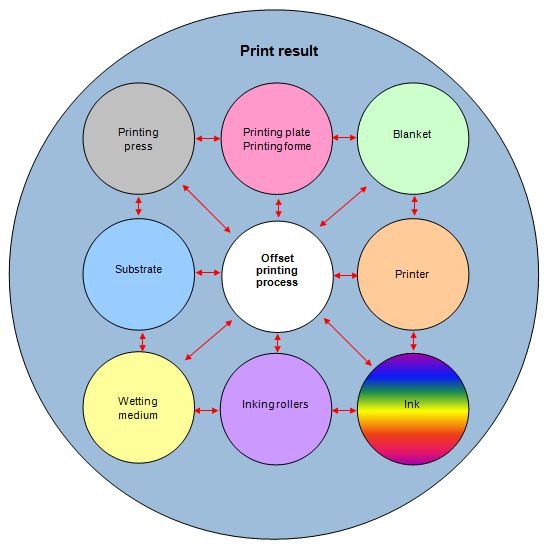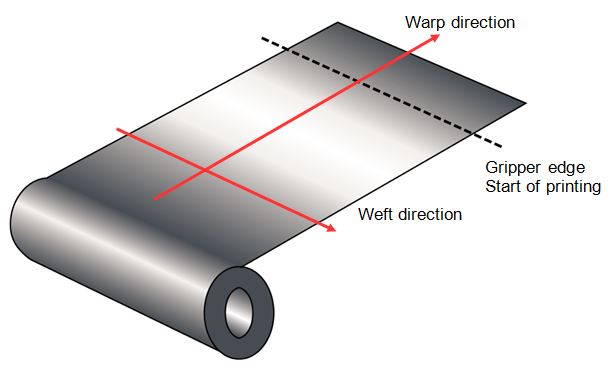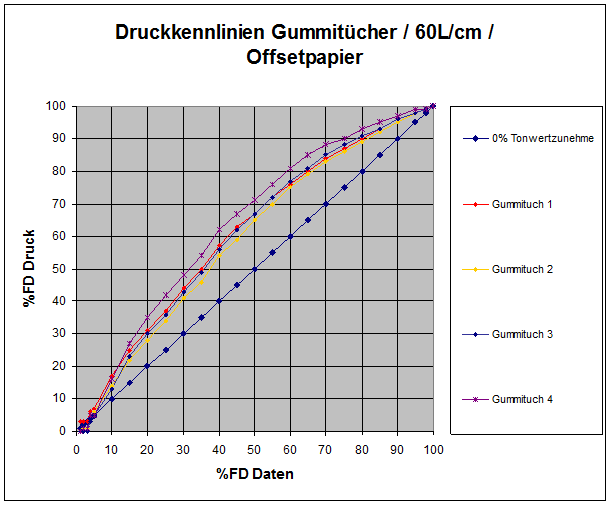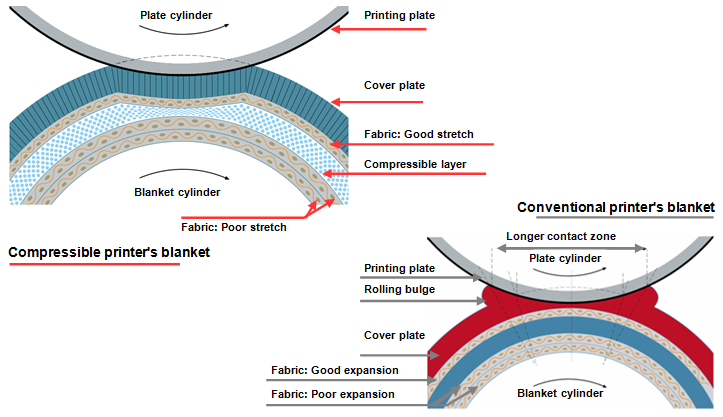03.03.2016


The factors influencing the print result of a printing process, especially in offset printing, are a frequent topic of lively discussion among printing technicians. The focus is usually on the printing press and the respective printing process, as this is where all the components required for printing come together. However, the print result also always reflects the interaction between the operating resources used, the materials, and the operating personnel. This series of articles discusses these influencing factors individually and describes them in detail.
The chart below shows the most important influencing factors, although the climate in the printing room—another influencing factor—is not discussed in detail due to significant regional differences.
Each of these influencing factors has a significant impact on the print result and is directly related to the other influencing factors. The last issue of Gallus In Touch took a closer look at the printing plate and its influencing parameters. Now we will examine the rubber blanket as an influencing factor in detail.
-2.png)
The graphic below shows the most important parameters influencing the printing quality and the print result.
-2.png)
.png)
.png)
The structure of a rubber blanket, which must also be able to absorb tangential shear forces (walking), has a decisive influence on its tear resistance, elasticity, compressibility, and resilience. Compressible rubber blankets are therefore generally used.

The direction of the weft and warp of the rubber blanket is also important. The warp direction, which is marked with lines on the back of the rubber blanket, always runs in the printing direction.

The rubber blanket is always selected according to its area of application. UV inks are mostly used in label printing, so the rubber blanket must also be resistant to UV inks and the corresponding cleaning agents. It is also important that the supplier adheres to the specified thickness tolerances. Compressible rubber blankets must have good resilience. For self-adhesive rubber blankets, which are mainly used on rotary label printing machines, attention must also be paid to the adhesive and release properties. Last but not least, run stability plays an important role in production.

For good print quality, the transfer of ink from the printing plate to the rubber blanket and then to the substrate plays a major role, with the surface quality of the rubber blanket being particularly important.
For good ink transfer, it is always important to ensure sufficient pressure between the printing plate cylinder and the rubber blanket cylinder, as well as between the rubber blanket cylinder and the impression cylinder (printing material). In screen printing, the screen dots should deform or enlarge as little as possible. This increase in tone value can vary with different rubber blankets, as shown in the printing characteristics below.
FD = Area coverage



The diagrams below show the walking behavior in the pressure zone between the plate cylinder and the rubber blanket cylinder. With compressible rubber blankets, the compressible layer is compressed by the pressure applied, while with conventional rubber blankets, the rubber layer on the surface is compressed, creating a roll bead. The situation is similar in the pressure zone between the rubber blanket cylinder and the impression cylinder. When compressible rubber blankets are used, the screen dots in the pressure zone are least deformed and also adapt better to the surface of the substrate. They are therefore not susceptible to thickness differences in the substrate web, e.g., adhesive joints that could press into the rubber blanket.
03.03.2016
The factors influencing the print result of a printing process, especially in offset printing, are a frequent topic of lively discussion among printing technicians. The focus is usually on the printing press and the respective printing process, as this is where all the components required for printing come together. However, the print result also always reflects the interaction between the operating resources used, the materials, and the operating personnel. This series of articles discusses these influencing factors individually and describes them in detail.
The chart below shows the most important influencing factors, although the climate in the printing room—another influencing factor—is not discussed in detail due to significant regional differences.
Each of these influencing factors has a significant impact on the print result and is directly related to the other influencing factors. The last issue of Gallus In Touch took a closer look at the printing plate and its influencing parameters. Now we will examine the rubber blanket as an influencing factor in detail.
The graphic below shows the most important parameters influencing the printing quality and the print result.
The structure of a rubber blanket, which must also be able to absorb tangential shear forces (walking), has a decisive influence on its tear resistance, elasticity, compressibility, and resilience. Compressible rubber blankets are therefore generally used.
The direction of the weft and warp of the rubber blanket is also important. The warp direction, which is marked with lines on the back of the rubber blanket, always runs in the printing direction.
The rubber blanket is always selected according to its area of application. UV inks are mostly used in label printing, so the rubber blanket must also be resistant to UV inks and the corresponding cleaning agents. It is also important that the supplier adheres to the specified thickness tolerances. Compressible rubber blankets must have good resilience. For self-adhesive rubber blankets, which are mainly used on rotary label printing machines, attention must also be paid to the adhesive and release properties. Last but not least, run stability plays an important role in production.
For good print quality, the transfer of ink from the printing plate to the rubber blanket and then to the substrate plays a major role, with the surface quality of the rubber blanket being particularly important.
For good ink transfer, it is always important to ensure sufficient pressure between the printing plate cylinder and the rubber blanket cylinder, as well as between the rubber blanket cylinder and the impression cylinder (printing material). In screen printing, the screen dots should deform or enlarge as little as possible. This increase in tone value can vary with different rubber blankets, as shown in the printing characteristics below.
FD = Area coverage
The diagrams below show the walking behavior in the pressure zone between the plate cylinder and the rubber blanket cylinder. With compressible rubber blankets, the compressible layer is compressed by the pressure applied, while with conventional rubber blankets, the rubber layer on the surface is compressed, creating a roll bead. The situation is similar in the pressure zone between the rubber blanket cylinder and the impression cylinder. When compressible rubber blankets are used, the screen dots in the pressure zone are least deformed and also adapt better to the surface of the substrate. They are therefore not susceptible to thickness differences in the substrate web, e.g., adhesive joints that could press into the rubber blanket.